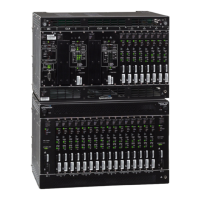114 097-55501-01 Issue 6 – June 2003
1
TimeHub 5500 System Guide
• You can also bring up a form that shows generalized
communication to and from the TimeHub. It is available from the
same menu that brings up the automatic message form
(Mode->Command Response). With this form in view, it is often
useful to observe the responses to the following TL1 commands,
each of which can be automatically generated from another menu
selection:
- RTRV-NETYPE-ALL (TL1Commands->RTRV-NETYPE-ALL or
F2): This command retrieves the current hardware configura-
tion of the TimeHub system (master and expansion shelves).
During the configuration you may want to select this to see
which components of the system have been identified so far.
- RTRV-COND (TL1Commands->RTRV-COND or F3): This com-
mand retrieves any conditions that are currently active. They
may or may not be alarm-generating.
- RTRV-ALRM (TL1Commands->RTRV-ALRM or F4): This com-
mand retrieves only conditions that are active and alarm-gener-
ating. For example, if only one power terminal is connected on
the expansion shelf, this would be reported in the response (as
well as indicated on the expansion controller card(s) front
panel(s)).
- Finally, when the hardware configuration is complete,
TimeScan THC can be used to configure expansion shelf
outputs as desired. See the last step in configuration process
for more info.
If you do not have TimeScan THC and use a terminal emulation program
instead, all of the above actions can still be performed; it will just involve
typing of commands or setting up scripts/special function keys to do so.
4. With no modules inserted in the expansion shelf, confirm that the
shelf is receiving power from both terminals by twisting out the fuse
connectors located at the upper left and upper right of the expan-
sion shelf. When twisting off the fuse holder (which simulates a
blown fuse on that terminal side), if the other terminal has power
the red LED will illuminate (indicating that power is not currently
being supplied by this terminal, which is of course expected since
the fuse is removed).
Thus, to check that terminal A is supplying power, temporarily remove
fuse B. If the fuse B LED illuminates terminal A is supplying power (of
course this doesn't confirm actual voltage and current supplying
capability). Similarly, to check that terminal B is supplying power,
temporarily remove fuse A. If the fuse A LED illuminates terminal B is
supplying power.

